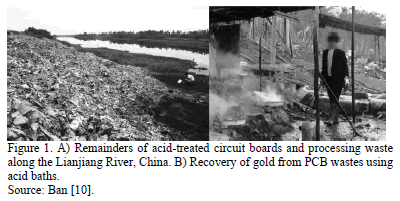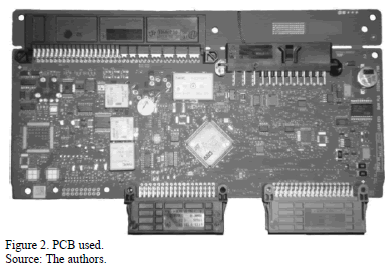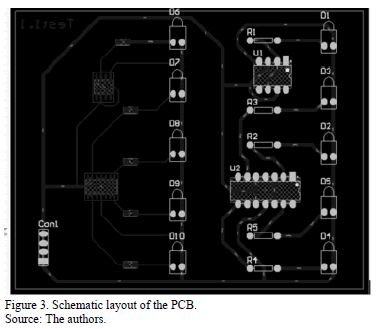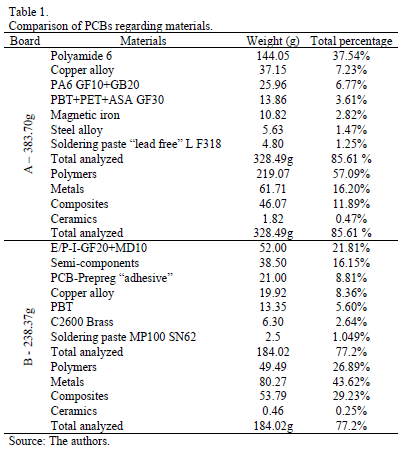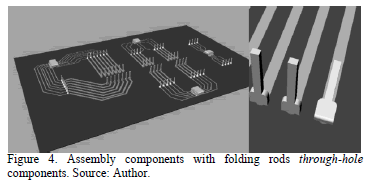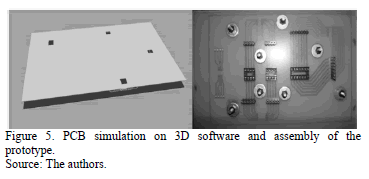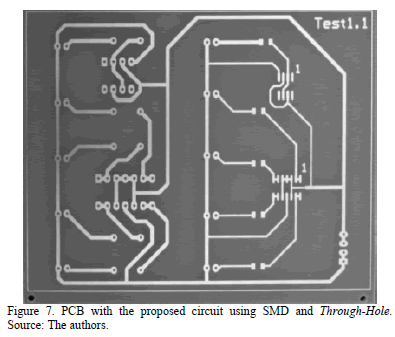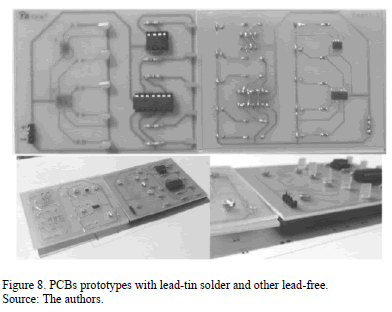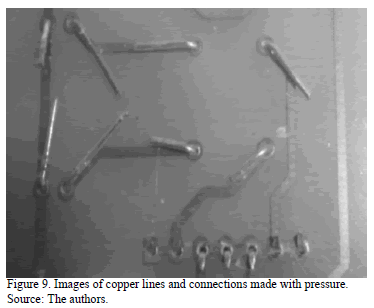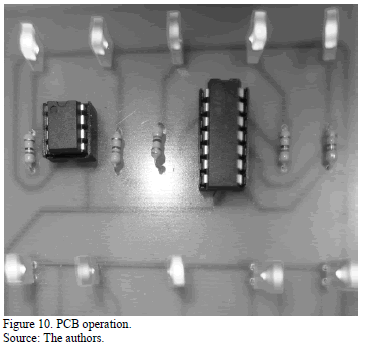Services on Demand
Journal
Article
Indicators
-
 Cited by SciELO
Cited by SciELO -
 Access statistics
Access statistics
Related links
-
 Cited by Google
Cited by Google -
 Similars in
SciELO
Similars in
SciELO -
 Similars in Google
Similars in Google
Share
DYNA
Print version ISSN 0012-7353
Dyna rev.fac.nac.minas vol.81 no.186 Medellín July/Aug. 2014
https://doi.org/10.15446/dyna.v81n186.39760
http://dx.doi.org/10.15446/dyna.v81n186.39760
Alternative methods to attach components in printed circuit boards to improve their recyclability
Métodos alternativos de fijación de componentes de circuitos impresos para mejorar su reciclabilidad
André Canal-Marques a, Maria Rita Ortega-Vega b, José-María Cabrera c & Célia de Fraga-Malfatti d
a Departamento de Metalurgia (DEMET)/PPGE3M, Universidade Federal do Rio Grande do Sul, Brazil, andrecm@unisinos.br
b Departamento de Metalurgia (DEMET)/PPGE3M, Universidade Federal do Rio Grande do Sul, Brazil, ortega.vega@ufrgs.br
c Universitat Politécnica de Catalunya, ETSEIB, Barcelona, Spain - Fundació CTM Centre Tecnológic, Materials Forming Area, Manresa, Spain, jose.maria.cabrera@upc.edu
d Departamento de Metalurgia (DEMET)/PPGE3M, Universidade Federal do Rio Grande do Sul, Brazil, celia.malfatti@ufrgs.br
Received: September 3th, de 2013. Received in revised form: March 19th, 2014. Accepted: July 22th, 2014
Abstract
Printed circuit boards (PCB), which form the basis of the electronics industry, generate wastes that are difficult to dispose of and recycle due to the diversity of their materials and components and their difficult separation. The replacement of Pb-Sn welding for lead-free alloys to attach components in printed circuit boards is an attempt to minimize the problem of Pb toxicity, but it does not change the problem of separation of the components for later reuse and/or recycling. This article presents a review of the environmental problem of printed circuit boards, the initial development of alternative fixation studies, and reliability tests for comparison with conventional boards and commercial systems to validate or serve as a basis for future research, focused on PCB disassembly for recycling. At present, initial studies were performed by using prototypes for visual and functional tests.
Keywords: Printed circuit boards, Welding replacement, Environmental problem, Recyclability.
Resumen
Las Placas de Circuitos Impresos constituyen la base de la industria electrónica. Sin embargo, generan residuos de difícil eliminación y reciclaje, debido a la diversidad de materiales y componentes presentes y su difícil separación. La sustitución de soldaduras de Pb-Sn por aleaciones libres de plomo intenta minimizar la toxicidad que implica la presencia de Pb, pero no aborda la separación de los componentes para su posterior reutilización y/o reciclaje. Este artículo presenta una revisión bibliográfica sobre el problema ambiental que constituyen las placas de circuitos impresos, el estudio de alternativas de fijación, pruebas de fiabilidad para comparar con las placas convencionales y sistemas comerciales para validar o servir de base para futuras investigaciones, enfocadas hacia el desmontaje de PCI. Además, se muestran algunos estudios incipientes mediante prototipos para la realización de pruebas visuales y funcionales.
Palabras clave: Placas de circuitos impresos, Reemplazo de soldadura, Problema ambiental, Reciclabilidad
1. Introduction
Currently, there are a large number of products that generate waste and significantly increase the volume of dumps and landfills due to innovation by the electronic industry. Much of the waste generated constitutes technological waste, whose recycling is being studied by several authors, due to its social and environmental relevance. Among these wastes, one of the most important are printed circuit boards (PCBs), which are the base of the electronic industry.
PCBs constitute a kind of waste with difficult disposal because their recycling is complex and expensive. The diversity of materials and components present in them make their separation difficult. Separation of electronic components and reusing of these materials require the removal of the solder, which is a complex process. Also and for the majority of cases, such components are unusable after that process due to the temperatures involved.
The PCBs construction process is currently migrating from traditional eutectic Pb-Sn alloy to different lead-free alloys. This replacement attempts to alleviate the problem
of Pb-Sn solder alloy, considered toxic, but does not change the component separation problem for reuse and/or recycling. Therefore, alternatives to the removal and disposal of these materials without harming the environment become a new challenge.
The discarded PCBs have attracted public and researchers attention [1-9], since among their components there are toxic materials such as heavy metals and brominated flame retardants (BFRs), causing enormous damage to the environment if they are not properly treated (Fig. 1).
In general, PCB waste components can be divided into metallic (MFs) and non-metallic fractions (NMF) [11]. NMF typical composition comprises thermosetting resins (epoxy), glass fiber, plastics, reinforcement materials, additives and other BFR, and constitute about 70wt-% of the PCB wastes. Thermosetting resins cannot be recast or remodeled because of their molecular structure and not recyclable [11]. The proportion of waste printed circuit boards WPCBs in electronics waste is approximately 3% [12,13].
Several authors [1, 14-21], argue that WPCBs plastics contain BFR, including polybrominated biphenyls (PBBs) and polybrominated diphenyl ethers (PBDEs). Their combustion generates highly toxic gases, called polybrominated dibenzodioxins and dibenzofurans, and dioxins and furans (PCDF/Fs) and glass fiber significantly reduces fuel efficiency. Traditionally, these nonmetallic materials are landfilled or incinerated resulting in wasted resources and aggravating the environmental problem [5, 22-26].
The metal fraction is comprised of ~16% of copper, ~4% of tin-lead, ~3% of iron, ~2% of nickel, ~0.05% of silver, ~0.03% of gold, ~0.01% palladium [14,17, 27-30] and even rare elements such as tantalum, covered or mixed with various plastics and ceramics [31]. Li [32] states that the purity of the precious metals in PCBs is 10 times higher than minerals rich in these elements. Cui and Zhang [33] argue that the main economic objective for e-waste recycling is the recovery of precious metals.
It is usually difficult and often confusing to quantify the environmental consequences associated with materials, processes and products. The difficulties are, for example, the determination of the environmental effects associated with the objects of the comparison, the almost impossible task of comparing different environmental effects and the amount of data needed to compare related products. Sometimes, the necessary data are also scarce or inaccessible, and then it is difficult to define the environmental load analysis. Furthermore, the electronic industry is extremely large and varied, characterized by long supply chains, and in the same way, indirect environmental impacts associated to their products [34].
There is a strong pressure from European companies not to accept most electronic products with a tin-lead solder printed circuit board, due to its toxicity. This type of welding is used, because of its easy installation and use, but, since European laws became highly restrictive for this type of material, it is important to study other types of welding, which are less aggressive to the environment [35].
Jie [36] argues that there is a growing environmental awareness around the world. Therefore, an economically viable environmental management system for the electro-electronic equipment end of life cycle is necessary. It is very important for sustainable development, as the effective cost and efficient environmental methods are needed to manage these wastes [29-30, 37-40].
According to Andrae [34] and other authors [41-43], a number of methods and tools related to environmental assessment, such as life cycle assessment (LCA) and carbon footprint, were proposed in order to indicate which alternative is better compared to others. Schematically, the life cycle of a product consists of four stages: material extraction and processing, manufacture, usage and end of life.
Griese et al. [44] argues that studies confirmed that lead is the material with the greatest potential to be removed and had to be banned to prevent uncontrolled releases; also, Pb-free alloys reduce the potential environmental impact of electronics. This requires a complete LCA and detailed study of the environmental performance of new materials substituents.
Some authors [45-48] realized that there is no simple replacement for traditional welding. They indicate that the introduction of lead-free solders reduces toxicity and potential risks in the electric-electronic waste removal. But lead-free solders are less efficient in terms of resource and energy consumption. Compared with traditional Sn-Pb solder, Pb-free materials manufacturing doubles the cost in industries, increases energy use and promotes the loss of valuable resources. In fact, Turbini et al. [49] recommend increasing the conventional Pb-based electronics recycling, instead of introducing lead-free solder. The main reason is to recycle copper in order to reduce the environmental problems associated with its primary production and mineral extraction.
Several studies are underway to reduce or completely eliminate welding in printed circuit board manufacture. These alternatives provide initial solutions to the problem, by reducing the use of soldering or replacing the welding by another fastener such as a resin. However, they do not solve the problem of separation. The ways in which electronic components are fixed in PCBs still lacks adequate solutions. Therefore, fixing mechanisms used on a printed circuit board are considered an open research topic.
Thus, this work reconsiders the alternatives for fixing the components on printed circuit boards, through studying the supports used in printed circuit boards, the existing types, properties and processes, seeking to explore alternatives to traditional fixing (welding) in a printed circuit board. Prototypes are made by mounting a board from established concepts and making comparative tests of reliability, compared to conventionally fixed boards for validation and providing a basis for future research.
The aim is to develop new alternatives and designs to improve the fastening through alternative systems that facilitate assembly, disassembly and maintenance of various components of the product during the separation process, prior to recycling. Until now, there have been some initial studies using prototypes for testing, including visual and functional testing.
2. Materials and methods
2.1. Study of two boards: Materials analysis
The present analysis was performed for two printed circuit boards regarding the percentage of each material, in order to evaluate the recycling viability. This study was conducted with the cooperation of a PCBs manufacturing company, located in the town of Valls (Tarragona-Barcelona) in Spain, which provided the boards and the initial data (Fig. 2).
2.2. Fixing of components by pressure
This work has applied for a patent with the INPI (National Institute of Industrial Property of Brazil), with the name Production Process of Printed Circuit Boards and the Resulting Product on 07/03/2013, number (BR 10 2013 005511 5).
The purpose of this study was to develop new methods for attaching electronic components on a printed circuit board, through alternative processes, and by selecting appropriate materials for these processes, aiming to sustainability. Six initial conceptual designs were analyzed. The criteria for the analysis were: mechanical fixing, electronic connection ability, electrical conductivity, ease of assembly/disassembly, and low amount of material used. In the present study, the component junctions were made by pressure. Boards were fabricated to test the technical feasibility, analyzing its initial run. The traditional process of manufacturing was maintained
with the addition of new steps after the traditional ones, where a series of procedures was carried out to make a board with fillets and holes adequate for mounting the electronic circuit.
In this method of attachment, the board is made of two parts, one with the printed circuit, which is pierced, and whose elements are fixed by pressing on the other board; this does not require welding. The contacts are made internally so that circuit designs are not visible. The elements junction is performed by the two boards placed one on the other, pressing the device and connections, and other items on the sides to further secure the assembly.
For this set a simple circuit was designed (Fig. 3) to be applied onto the board and the components to be fixed, in order to test the proposal regarding the electrical resistance at each point of the fixed contact elements, and therefore test the initial conceptual model feasibility. Virtual and physical prototypes were performed. The next step was a functional prototype building. For this prototype, a two-faced positive photosensitive board was used, with dimensions of 100x160mm, made with fiberglass epoxy resin (FR4), fire resistant insulation and covered with a conductive copper thin film on both sides. A circuit with components for SMD (Surface Mount Device) and Through-hole were designed to test the two types that are currently used. 10 resistances (5 SMD and 5 Through-hole), 10 Through-hole LEDs, 10 "chips" (5 SMD and 5 Through-hole) and a battery connected to the system to verify operation were used. After the traditional steps to create a PCB were carried out, a series of procedures was performed leading to a track with the same size of the board and the suitable holes for mounting an electronic circuit.
In order to compare the proposed system with the welding-fixed systems, three prototypes were fabricated using the same method: The first prototype, with junctions of tin-lead (60Sn-40Pb), the second one, lead-free welded (99.3 Sn-0.7Ag), and the third, with the previously described junction method.
2.3. Tests performed
At this stage, prototypes were submitted to reliability, visual and operating tests.
2.3.1. Visual test
Visual analysis was performed as the first characterization of prototypes. A visual inspection of the board can help to identify and troubleshoot contacts.
2.3.2. Performance test
The performance test consists of checking the correct operation of the board, determining the integrity of all electrical connections and checking all LED points, in order to identify some damaged points and components within the circuit in real working conditions.
2.3.3. Pending tests
The following tests will be carried out in the continuation of this work: Test of corrosion and humidity electric endurance test and thermal-mechanical fatigue.
3. Results and analysis
3.1. Study of two boards: Materials analysis
The percentage of each material in these two printed circuit projects was calculated from data provided by the company. In Table 1, the composition of the materials with greater presence in the printed circuit board and a comparison between the two boards studied, in relation to the percentage of the materials, are shown.
There is a high weight percentage of polymeric materials. Polyamide 6 is the material for the base of board. Also, there is the presence of solder paste LF318 (Sn98.5/Ag1/Cu0.5) representing 1.25% of the total weight of the printed circuit board. The main component of the solder, Sn, is a metal component considered moderately toxic. In the second board there is a high weight percentage of composite materials over other materials; the reinforced glass fiber is the base material for the PCB
From Table 1, it can be seen that there is a great difference in the amount of material used for the two boards. Each board consists of a specific design for a particular use, so its components change considerably. This indicates how difficult the identification and separation of the materials can be, as well as the complexity of PCB recycling.
3.2. Fixing
The physical and virtual prototypes of the first tests are shown in Fig.s 4, 5 and 6. The main objective of these prototypes is to test the electrical resistance at each contact point between the fixed elements and, therefore, to test the feasibility of the initial concept.
From the first prototype, a new circuit design with LEDs was used to test the performance of the attachment system. Fig. 6 shows the virtual prototype and Fig. 7, the physical prototype. This circuit design is more functional, simpler and with higher quality.
In Fig. 8 the three prototypes appear in their respective order, in order to compare different procedures and finishing of the boards. The third prototype has the characteristic of not using welding for component junctions, and hence facilitates disassembly and reuse of components; this binding is non-permanent.
3.3. Tests results
3.3.1. Visual test
In this test copper lines and connections between the track and the components were visually checked, seeking out possible errors. The result showed that the defects were not detected visually in the system (Fig. 9).
3.3.2. Performance test
In this test, we examined the operation of the system through the operation check on all connection points with the illumination of the "LEDs", shown in Fig. 10. Note that the LEDs were lighted due to the pressure maintained in the system. The identification of this problem will help to improve other prototypes.
3.3.3. Pending tests
Prototypes will be developed with better quality and with variations for comparison. The tests will be conducted in the ITT Fuse (Technological Institute for Testing and Functional Safety) of the UNISINOS (Universidade do Vale do Rio dos Sinos). Each prototype will perform an operation analysis, visual analysis, analysis of the electrical resistance and X-ray diffraction before and after the test. The tests to be performed will be of thermal cycles, salt spray, thermal shock and vibration.
4. Conclusion
There is a recent interest in the research of new technologies for the recycling of printed circuit boards generated by the growth of the electronics industry, which constitute an environmental problem when they are disposed of, a subject which has been extensively studied. In addition, regulations and laws in Europe have become stricter regarding specifications of electronic components; therefore, it is necessary to conduct further studies on the effects of these rules and laws in other countries.
Given the difficulty of recycling electronic wastes, studies are focused on the development of techniques which facilitate the reuse of these products and/or their components. The methods of fixing and joining of components in the PCBs have become increasingly popular among researchers, with a significant increase in studies of lead-free solders. However, it is necessary to conduct studies related to alternatives to traditional processes that do not yet have the attention of researchers and companies, and to take into account the performance of the final product (LCA), through integrated approaches in terms of processes, materials and technologies.
The idea of eliminating the use of welding is not new, but the methods previously proposed (for example, replacement with conductive adhesive) have not been accepted by the market, presumably due to operating difficulties or unreliability. Only a few works exist which propose alternatives to the traditional procedure.
This initial study is essential to guide new research, generate alternatives and test them for specific applications. Currently, ways in which the electronic components are fixed to printed circuit boards still lack suitable alternatives to replace them. Therefore, an alternative fixing PCBs was proposed, and tested and compared with traditional forms. The first performance test showed positive results with regard to the operation of the circuit elements. The prototypes were hand-made and showed reasonable quality. Better quality is expected in later works, due to prior knowledge of the construction and operation of the first prototype.
Acknowledgements
The authors wish to acknowledge the financial support of CAPES (Brazilian Government Agency for Human Resources Development), CNPq (Brazilian National Council for Scientific and Technological Development) and the Euro Brazilian Windows II Project (EBW II).
References
[1]. Cui, J. and Forssberg, E., Mechanical recycling of waste electric and electronic equipment: A review. Journal of Hazardous Materials, 99, pp. 243-263, 2003. [ Links ]
[2]. AEA TECHNOLOGY: WEEE & Hazardous Waste, A report produced for DEFRA. Aea, 2004. [ Links ]
[3]. Wang, D., Cai, Z., Jiang, G., Leung, A., Wong, M. H. and Wong, W. K., Determination of polybrominated diphenyl ethers in soil and sediment from an electronic waste recycling facility. Chemosphere, 60, pp. 810-816, 2005. [ Links ]
[4]. EPS CANADA, Electronics Product Stewardship Canada: Environmentally Sound Recycling of Electronics. Guidance document, Canada, EPS 2006. [ Links ]
[5]. Owens, C.V., Lambright, C., Bobseine, K., Ryan, B., Gray Jr., R. E., Gullett, B. K. and Wilson, V. S., Identification of estrogenic compounds emitted from the combustion of computer printed circuit boards in electronic waste. Environmental Science and Technology, 41, pp. 8506-8511, 2007. [ Links ]
[6]. Leung, A. O. W., Duzgoren-Aydin, N. S., Cheung, K. C. and Wong, M. H., Heavy metals concentrations of surface dust frome-waste recycling and its human health implications in Southeast China. Environmental Science and Technology, 42, pp. 2674-2680, 2008. [ Links ]
[7]. Vasile, C., Brebu, M.A., Totolin, M., Yanik, J. Karayildirim, T. and Darie, H., Feedstock recycling from the printed circuit boards of used computers. Energy Fuel, 22, pp. 1658-1665, 2008. [ Links ]
[8]. Sepúlveda, A., Schuluep, M., Renaud, F. G., Streicher, M., Kuehr, R., Hagelüken, C. and Gerecke, A. C., A review of the environmental fate and effects of hazardous substances released from electrical and electronic equipments during recycling: Examples from China and India. Environmental Impact Assessment Reviews, 30, pp. 28-41, 2010. [ Links ]
[9]. Zhou, Y. and Qiu, K., A new technology for recycling materials from waste printed circuit boards. Journal of Hazardous Materials, 175, pp. 823-828, 2010. [ Links ]
[10]. BAN, Exporting Harm: The High-Tech-Trashing of Asia, SVTC. Availaible: http://www.ban.org/e-waste/technotrashfinalcomp.pdf [ Cited 15 May 2013 ] [ Links ].
[11]. Guo, J., Guo, J. and Xu, Z., Recycling of non-metallic fractions from waste printed circuit boards: A review, Journal of Hazardous Materials, 168 (2-3), pp. 567-590, 2009. [ Links ]
[12]. Bernardes, A., Bohlinger, I. and Rodriguez, D., Recycling of printed circuit boards by melting with oxidising/reducing top blowing process. In: B. Mishra (Ed.), Proceedings of Sessions and Symposia Sponsored by the Extraction and Processing Division, TMS Annual Meeting, Orlando, FL, USA, 1997, pp. 363-375. [ Links ]
[13]. Basdere, B. and Seliger, G., Disassembly factories for electrical and electronic products to recover resources in product and material cycles, Environmental Science and Technology, 37, pp. 5354-5362, 2003. [ Links ]
[14]. Richter, H., Lorenz, W. and Bahadir, M., Examination of organic and inorganic xenobiotics in equipped printed circuits, Chemosphere, 35, pp. 169-179, 1997. [ Links ]
[15]. Menad, N., Bjorkman, B. and Allain, E.G., Combustion of plastics contained in electric and electronic scrap, Resources, Conservation and Recycling, 24, pp. 65-85, 1998. [ Links ]
[16]. Riess, M., Ernst, T., Popp, R., Müller, B., Thoma, H., Vierle, O., Wolf, M. and Van Eldik, R., Analysis of flame retarded polymers and recycling materials, Chemosphere, 40, 937-941, 2000. [ Links ]
[17]. Vehlow, J., Bergfeldt, B., Jay, K., Hunsinger, H. and Mark, F.E., Thermal treatment of electrical and electronic waste plastics, Waste Management & Research. 18, 131-140, 2000. [ Links ]
[18]. Ebert, J. and Bahadir, M., Formation of PBDD/F from flame-retarded plastic materials under thermal stress, Environmental International, 29, pp. 711-716, 2003. [ Links ]
[19]. Schlummer, M., Gruber, L., Mäurer, A., Wolz, G. and Van Eldik, R., Characterization of polymer fractions from waste electrical and electronic equipment (WEEE) and implications for waste management, Chemosphere, 67, 1866-1876, 2007. [ Links ]
[20]. Dimitrakakis, E., Janz, A., Bilitewski, B. and Gidarakos, E., Small WEEE: determining recyclables and hazardous substances in plastics, Journal of Hazardous Materials, 161, pp. 913-919, 2008. [ Links ]
[21]. Taurino, R., Pozzi, P. and Zanasi, T., Facile characterization of polymer fractions from waste electrical and electronic equipment (WEEE) for mechanical recycling, Journal of Waste Management, 30, pp. 2601-2607, 2010. [ Links ]
[22]. Rotter, S., Schwermetalle in Haushaltsabfällen (Heavy Metals in Household Waste), Doctoral Thesis, Edited by Forum für Abfallwirtschaft und Altlasten e.V.Pirna, Germany, 2002. [ Links ]
[23]. Jang, Y. C. and Townsend, T. G., Leaching of lead from computer printed wire boards and cathode ray tubes by municipal solid waste landfill leachates, Environmental Science and Technology, 37, pp. 4778-4784, 2003. [ Links ]
[24]. Hagelüken, C., Improving metal returns and eco-efficiency in electronics recycling - a holistic approach for interface optimization between preprocessing and integrated metals smelting and refining, In: Proceedings of IEEE International Symposium on Electronics and the Environment, San Francisco, USA, 2006, pp. 218-223. [ Links ]
[25]. Huang, Y., Takaoka, M., Takeda, N. and Oshita, K., Partial removal of PCDD/Fs, coplanar PCBs, and PCBs from municipal solid waste incineration fly ash by a column flotation process, Environmental Science and Technology, 41, pp. 257-262, 2007. [ Links ]
[26]. Janz, A., Rotter, V. S. and Bilitewski, B., Transfer of heavy metals released by WEEE and batteries into the high caloric fraction during MBT-processes, In: Proceedings of First International Conference on Hazardous Waste Management, Chania, Greece, 2008, 5 P. [ Links ]
[27]. Iji, M. and Yokoyama, S., Recycling of printed wiring boards with mounted electronic components, Circuit World, 23, pp. 10-15, 1997. [ Links ]
[28]. Ernst, T., Popp, R. and Van Eldik, R., Quantification of heavy metals for the recycling of waste plastics from electrotechnical applications, Talanta, 53, 347-357, 2000. [ Links ]
[29]. Veit, M. H., Pereira, C. D. C. and Bernardes, A. M., Using mechanical processing in recycling printed wiring boards, JOM, 54, pp. 45-47, 2002. [ Links ]
[30]. Goosey, M. and Kellner, R., Recycling technologies for the treatment of end of life printed circuit boards (PCBs), Circuit World, 29, pp. 33-37, 2003. [ Links ]
[31]. Hoffmann, J. E., Recovering precious metals from electronic scrap, JOM,. 44, pp. 43-48, 1992. [ Links ]
[32]. Li, J., Shirivastava, P., Gao, Z. and Zhang, H., Printed circuit board recycling: a state of the-art survey, Electronics Packaging Manufacturing, IEEE Transactions on, 27, pp. 33-42, 2004. [ Links ]
[33]. Cui, J. and Zhang, L., Metallurgical recovery of metals from electronic waste: A review, Journal of Hazardous Materials, 158, pp. 228-256. 2008. [ Links ]
[34]. Andrae, A. S. G., Global life cycle impact assesments of material shifts: The example of a Lead-free electronics industry, Springer. Hardcover. 183 P., 2010. [ Links ]
[35]. Nogueira, C. L. A., Queiroz-Neto, J. P. and Manzato, L. O., Impacto do uso de solda lead-free no processo de tecnologia de montagem em superfície (SMT), II Congresso de Pesquisa e Inovação da Rede Norte Nordeste de Educação Tecnológica. João Pessoa - PB,Brasilm 2007. [ Links ]
[36]. Jie, G., Ying-Shum, L. and Mai-Xi, L., Product characterization of waste printed circuit board by pyrolysis, Journal of Analytical and Applied Pyrolysis, 83, pp. 185-189, 2008. [ Links ]
[37]. Zong, G., Jianzhi, L. and Hong, C. Z., Printed circuit board recycling: a state-of art survey. Proceedings IEEE International Symposium on Electronics and the Environment, pp. 234-241, 2002. [ Links ]
[38]. Kang, H. Y. and Schoenung, J. M., Electronic waste recycling: A review of U.S. infrastructure and technology options, Resources, Conservation and Recycling, 45, 368-400, 2005. [ Links ]
[39]. Sinha-Khetriwala, D., Kraeuchib, P. and Schwaninger, M. A., Comparison of electronic waste recycling in Switzerland and in India, Journal of Environmental Impact Assessment Reviews, 25, pp. 492-504, 2005. [ Links ]
[40]. Eswaraiah, C., Kavitha, T., Vidyasagar, S. and Narayana, S., Classification of metals and plastics from printed circuit boards (PCB) using air classifier, Chemical Engineering and Processing: Process Intensification, 47, 565-576, 2008. [ Links ]
[41]. Botin, J. A., Integrating sustainability down to the operational levels of a mining company, DYNA, 77 (161), pp. 43-49, 2010. [ Links ]
[42]. Seijo-García, M. A., Filgueira-Vizoso, A. y Muñoz-Camacho, E., Consecuencias positivas de la implantación de la certificación ISO 14001 en las empresas gallegas (España), DYNA 80 (177), pp. 13-21, 2013. [ Links ]
[43]. Ortiz-Rodríguez, O. and García-Cáceres, R., Assessing sustainability within the construction industry by means of a composite indicator, DYNA, 80 (182), pp. 15-24, 2013. [ Links ]
[44]. Griese, H., Muller, J. and Reichl, H., Environmental assessment of lead free interconnection systems. Symposium on Lead Free Interconnect Technology, SMTA, Boston, MA, June 13-14. 2000. [ Links ]
[45]. Suganuma, K., Lead-free soldering in electronics: Science, technology and environmental impact. CRC Press. 2003. [ Links ]
[46]. Suganuma, K. and Kim, K. S., Sn-Zn low temperature solder, Lead-Free Electronic Solders, 18, 121-127, 2007. [ Links ]
[47]. Mihaescu, R. and Carstea, H., Ecological technologies for soldering without lead in electronic and telecommunications - today and tomorrow, Proc 26th Int Spring Seminar on Electron Technol: Integrated Managem of Electron Mater Prod, High Tatras, Slovak Republic, 2003, pp. 232-234. [ Links ]
[48]. Deubzer, O., Explorative study into the sustainable use and substitution of soldering metals in electronics, PhD thesis, Delf University, Delft, the Netherlands. 2007. [ Links ]
[49]. Turbini, L., Munie, G., Bernier, D. et al., Examining the environmental impact of lead-free soldering alternatives, Electronics Packaging Manufacturing, IEEE Transactions on, 24, pp. 4-9. 2003. [ Links ]
[50]. IPC-A-600G - Acceptability of Printed Board, 2004. [ Links ]
A. Canal-Marques, is Product Designer from the UNIJUÍ-RS. He is Specialist in Graphic Expression from PUC-RS. He earned MSc. in Materials Engineering from Universidade Federal do Rio Grande do Sul - UFRGS and studies Doctorate in Materials Engineering in the same University. He carried out part of his Doctorate study in Universitat Politècnica de Catalunya. Currently, he is professor in Design, Architecture and Materials Engineering in Universidade do Vale do Rio dos Sinos - UNISINOS, where he also coordinates the Material and Product Design course. He is advisor in the Waste Base Council of the FIERGS.
M. R. Ortega-Vega, is Chemical Eng. by Universidad del Atlántico. She studies MSc. in Materials Science and Technology in Universidade Federal do Rio Grande do Sul - UFRGS.
J. M. Cabrera, is currently a Full Professor in the Department of Materials Science and Metallurgical Engineering of the UPC, is responsible for the Materials Forming Area in Fundació CTM Centre Tecnológic, Manresa, Spain. He teaches subjects Technology of Materials, Materials Selection in Design, Physical Metallurgy and Nanomaterials and Nanotechnology at the Technical School of Industrial Engineering of Barcelona.
C. de Fraga-Malfatti is currently professor and researcher of the Department of Metallurgy in Universidade Federal do Rio Grande do Sul - UFRGS. She received her Bs. In Metallurgical Engineering and MSc. in Materials Science and Technology from UFRGS. She earned Doctorate degree from UFRGS and Université Paul Sabatier, Toulouse III.













